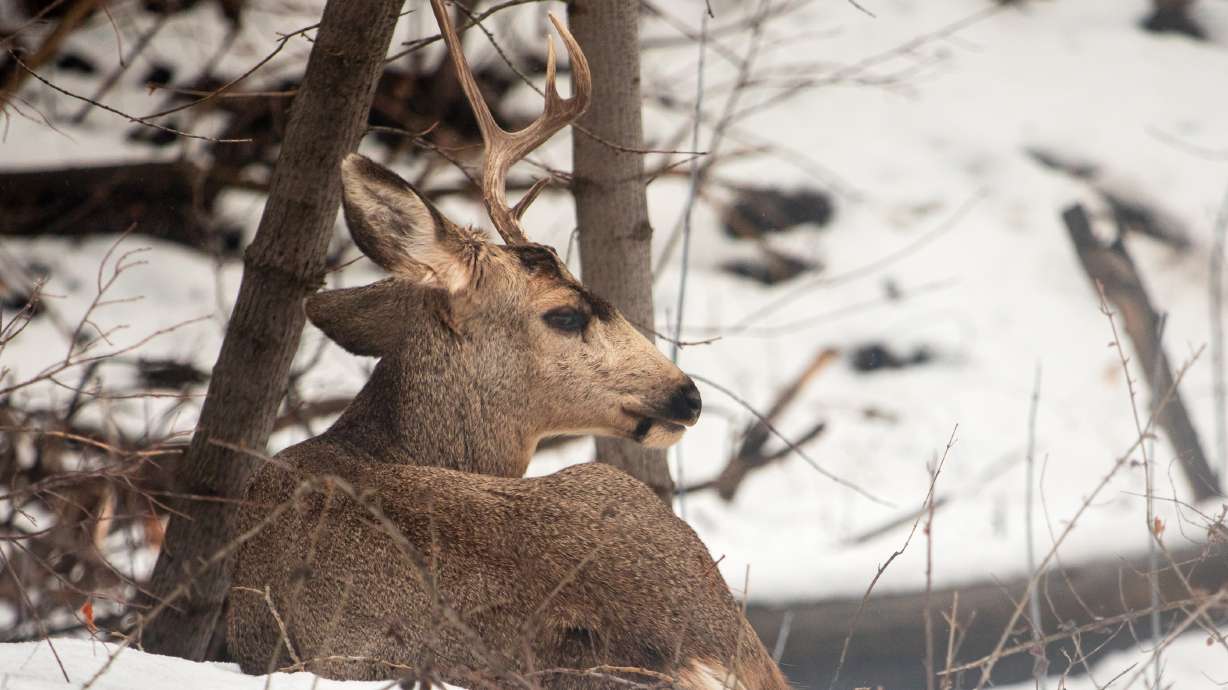Estimated read time: 4-5 minutes
This archived news story is available only for your personal, non-commercial use. Information in the story may be outdated or superseded by additional information. Reading or replaying the story in its archived form does not constitute a republication of the story.
SALT LAKE CITY — After years of cuts, Utah wildlife officials are proposing an increase of 6,800 general season buck deer hunting permits for this year's hunting season, despite the number of deer remaining well below the desired population.
The recommended changes are within this year's proposed big game permit allocations the Utah Division of Wildlife Resources unveiled on Friday. The agency is also proposing some changes to elk hunting permits and other big game species.
The Utah Wildlife Board is scheduled to vote on the measures in May before any figures are finalized.
A buck permit increase
Utah's mule deer population often goes through cycles, and right now it remains on a downward slope as a result of different factors, including drought and a harsh winter.
The state's estimated population has now fallen to below 300,000 deer, well shy of the target population objective of 404,900, according to graphs released by the division in a video explaining the recommendations posted on Friday.
The good news is there are signs recovery is on the horizon.
"Things are looking really positive as far as survivals over (this winter)," said Dax Mangus, big game coordinator at the Utah Division of Wildlife Resources, in the video. "Deer are in fantastic condition. The winter conditions have been normal to mild, and we're seeing fawn survival and adult doe survival on some units — especially in southern Utah — it looks like record-setting."

So why is there a proposed increase in hunting permits?
Permits are issued to manage population size, improve herd or habitat health, or reduce conflicts on private property. Deer hunting permits are generally decided after weighing several factors. These include previous season success rates, adult doe and fawn survival, fawn production, predator balance and the quality of the deer habitat, which can be influenced by the climate.
Many of the cuts made over the past few years were done to account for extreme drought throughout the state, which wiped out food options and worsened deer conditions. It's a big reason why the estimated deer population dropped the way it did. While last year's record snowpack erased many short-term drought conditions, there were some additional permit cuts in northern Utah to account for the harsh conditions the populations there endured.
Some of the vital fawn and doe survival and production figures remain down, likely because the species is still recovering from last winter, Mangus said.
But the division's permit recommendations don't take into account the number of buck deer in the state. That's because biologists don't believe that's a major deer population driver, he explained. Instead, managers rely on the state's buck-to-doe ratio to make decisions.
This year's estimated buck-to-doe ratio is about 21 bucks per 100 does, slightly above the state's objective of 15 to 20 bucks per 100 does. It's about the same as the previous year, which means managers are more open to re-establishing some of the permits that have been cut in recent years.
"The way we hunt buck deer in Utah doesn't drive deer populations, but what happens with deer populations drives how we hunt buck deer," he said. "There's room for some more opportunity to allow folks to hunt bucks and still manage to our objectives."
The division is recommending a total of 71,525 general-season buck deer permits this year. The increases are spread out in units all over the state, especially in areas where habitat conditions are better this year than in previous years.
It's also recommending 1,339 limited-entry deer permits, which is 40 more than last year, and 450 antlerless deer permits, 80 fewer than last year.
Elk and other big game
The agency also unveiled new recommendations for elk and other big game species that generally aren't as impacted by habitat conditions the same way deer are.
State wildlife officials are requesting 15,000 general-season bull elk permits for adults using any legal weapon and muzzleloader hunters in the early season, as well as unlimited permits for youth and archery hunters. There would also be no cap for late-season hunters. Utah offered just 15,000 permits total last year.
They're also proposing another 15,000 general-season spike bull elk permits with a cap of 4,500 multi-season permits, as well as:
- 19,626 antlerless elk permits (231 fewer than 2023).
- 3,415 limited-entry bull elk permits (79 more than 2023).
- 750 youth draw-only any bull/hunter's choice elk permits (same as 2023).
As for other big game species, the division is recommending:
- 1,506 buck pronghorn permits (155 more than 2023).
- 210 doe pronghorn permits (55 more than 2023).
- 101 bull moose permits (one fewer than 2023).
- 95 mountain goat permits (one more than 2023).
- 94 bison permits (83 fewer than 2023).
- 76 desert bighorn sheep (one more than 2023).
- 57 Rocky Mountain bighorn sheep permits (five more than 2023).
- 12 antlerless moose permits (three more than 2023).
- Five Rocky Mountain bighorn sheep ewe permits (same as 2023).
The proposed changes are slated to be discussed at five regional advisory council meetings scattered throughout the state in April before the Utah Wildlife Board is expected to vote on the measure during its May 2 meeting at the Eccles Wildlife Education Center in Farmington.
Public comment on the proposed permit changes will remain open until April 25.










